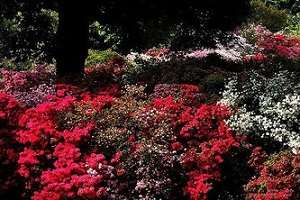By Eileen East
One of the marvels of landscaping is the perennial border. It's the poster child for a traditional English cottage look. In my imagination, tiny front yards are converted to ever blooming floral oases with a cobblestone path that leads one through the garden to the front door of a thatch roof cottage.

Whether it's an English cottage garden or the ever-popular American style mixed border, plants are in continuous bloom from April through October. Bees and birds are busy in abundant sunshine and under blue skies.
That's why the famous British landscaper Christopher Lloyd's wonderful classic, Succession Planting for Year-Round Pleasure, is such a great read. Lloyd was a master of the perennial border. An amazing amount of work is needed to keep a meadow or a border in top condition, and the book can guide you.
It's tricky to get plants to cooperate in a mixed border and invasive weeds can move in. Insects and disease can devastate a beautiful planting. From the viewpoint of the plants, it is about competition for resources.
Successful succession planting is an art. Like Japanese bonsai, each plant must be carefully evaluated before it is planted, and you may have to be ruthless about culling. A formerly well-behaved plant may take over if it is not controlled. Usually in my garden, when a plant reseeds all over the place, it is doomed. However, I make an exception for blue forget-me-nots. They seed like crazy, but they are so lovely. Plants that sucker freely and pop up in unexpected places can be a nightmare in a mixed border. I had a vinca that suddenly shot out in every direction after two or three years of staying where I put it. Removing it took me two years.
I believe in two principals when designing a border:
- Small flowering shrubs add structure and interest all season long. Dwarf azaleas are a great little shrub for structure. They are completely dependable and easy to transplant if necessary.
- Annuals fill in gaps and mask perennials that have been cut back or are looking shabby.
When you pick plants for succession planting, think about how they will share resources. Each square foot of land may be occupied in succession by several different species over the course of the season.
Daffodils are a workhorse but their foliage after blooming may be troublesome to some. I like to pair them with a deciduous azalea because they distract the eye from the bare shrub which doesn't come into bloom until the daffodils are finished flowering.
I plant lavender and columbine in front of the daffodils, and the daffodil foliage is a nice backdrop to the lovely columbine flowers. Finally, I use annual New Guinea impatiens in the same area because the columbine will disappear and the lavender doesn't show from a distance.
If you dream of meadows and perennial borders, I recommend you read Christopher Lloyd's book and spend the winter months drawing up a plan complete with a plant list. Prepare your soil well before you start, and mulch with undyed wood chips to conserve moisture and keep weeds down. When your lovely border is blooming, your dream will have come true.
Note: "Succession Planting for Year-Round Pleasure" is no longer in print. However, used copies are available through Amazon and at other used bookstores.
Source: psu.edu